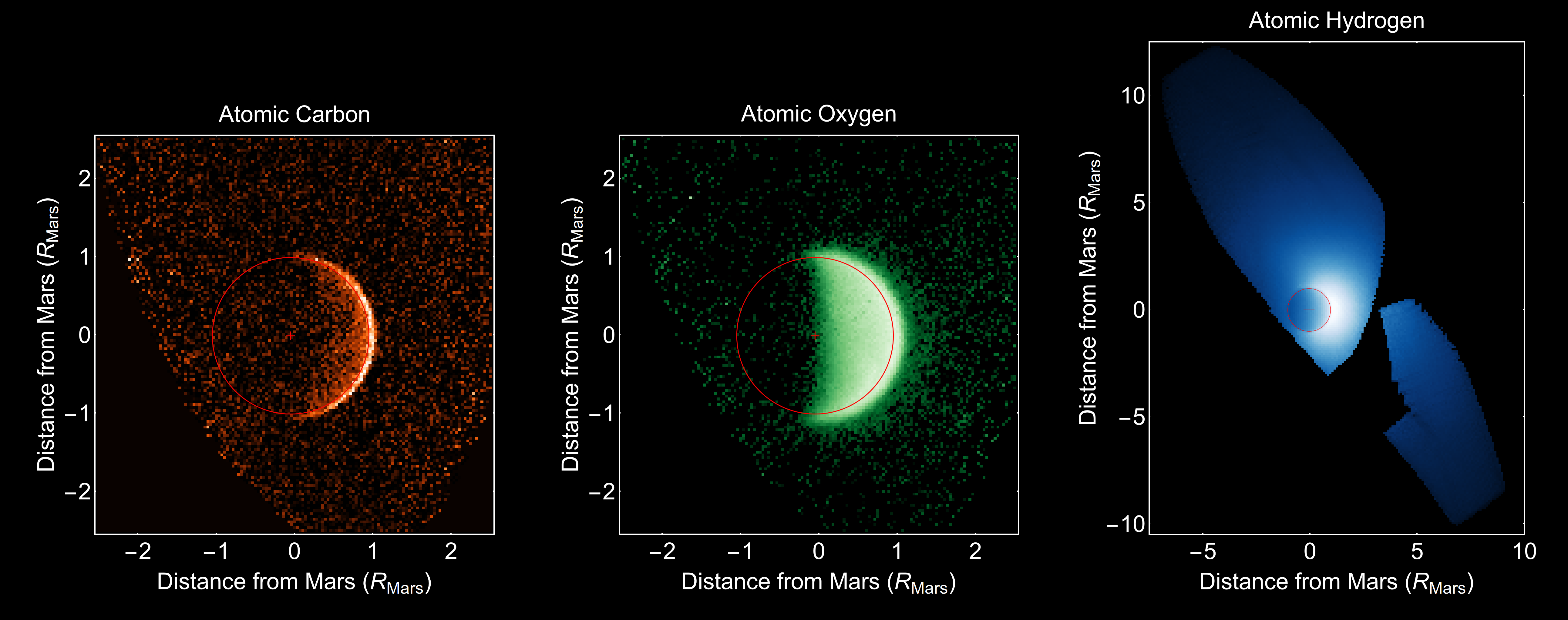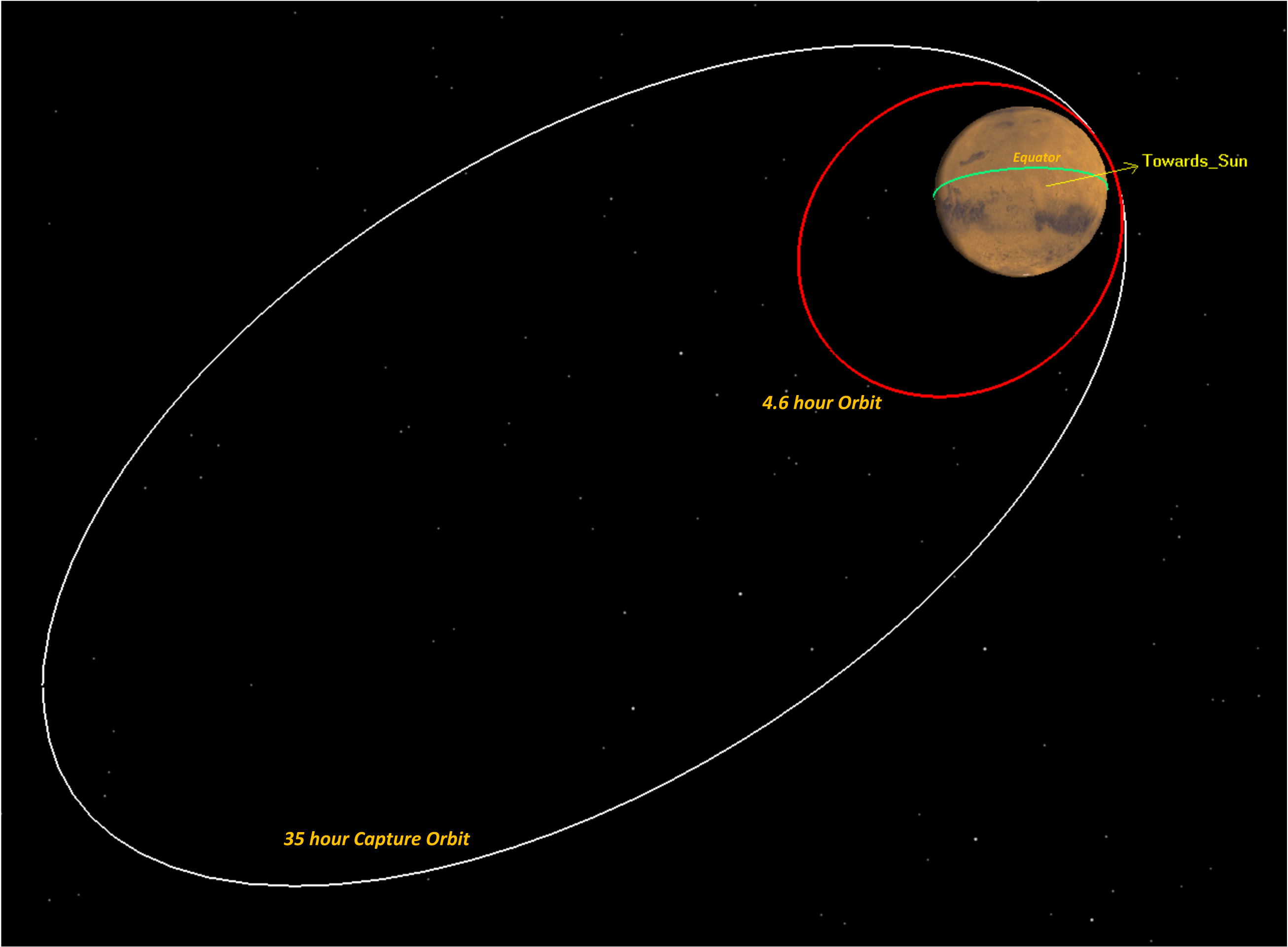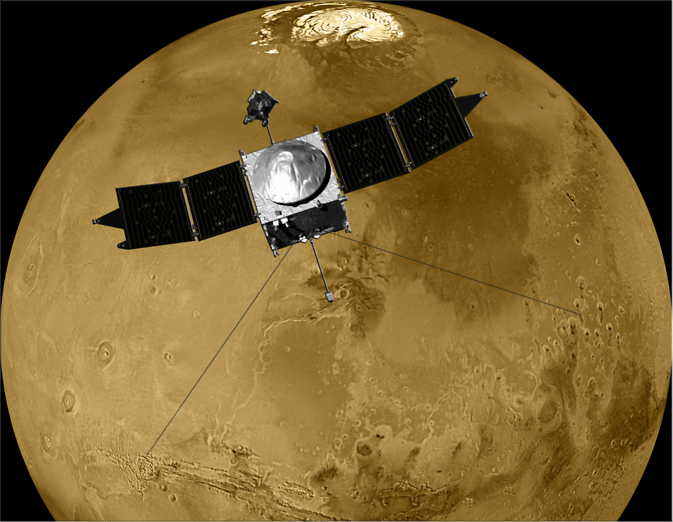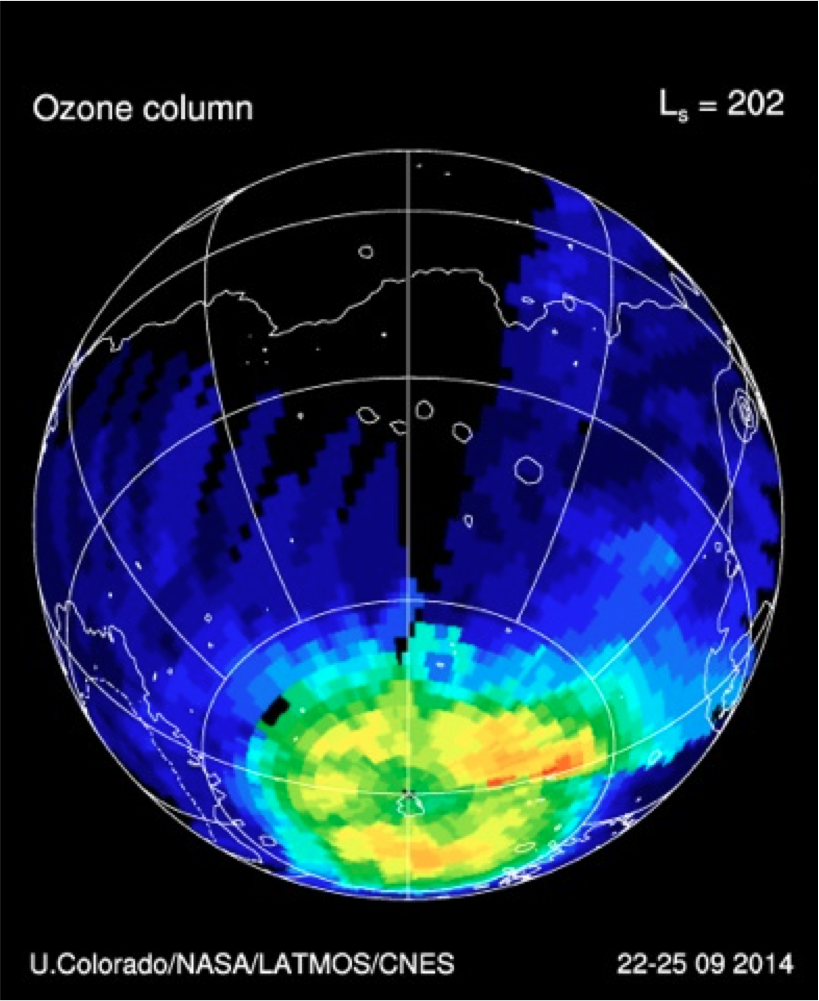
NASA’s new MAVEN Mars orbiter has taken a series of unprecedented images in its first science campaign since achieving orbit barely three weeks ago and delivered results that are “tantalizing” scientists with the rich rewards expected to come from a spacecraft that has been a decade in the making.
The science team leading NASA’s Mars Atmosphere and Volatile Evolution (MAVEN) mission discussed the early results derived from unprecedented ultraviolet images of the tenuous oxygen, hydrogen, and carbon coronas surrounding the Red Planet at a NASA news conference on Wednesday, Oct. 15.
The tenuous hydrogen and oxygen coronas of Mars lie at the outer fringe of the planet’s upper atmosphere, where the edge of the atmosphere meets space.
By observing all of the products of water and carbon dioxide breakdown, MAVEN’s remote sensing team can characterize the processes that drive atmospheric loss on Mars (see image above).
The $671 million MAVEN spacecraft’s goal is to study Mars’ upper atmosphere in detail for the first time and to explore the mechanisms of how the planet lost its atmosphere and water over billions of years.
Scientists will use measurements from the spacecraft’s Imaging Ultraviolet Spectrograph (IUVS) instrument to determine the rate of loss of these atoms to space that were once a part of carbon dioxide or water molecules near the surface. IUVS is sensitive to the sunlight reflected by these atoms.
“What we’re seeing so far is really just a tantalizing teaser of what’s to come,” MAVEN principal investigator Bruce Jakosky, of the Laboratory for Atmospheric and Space Physics at the University of Colorado, Boulder, said during the NASA media briefing on Wednesday, Oct. 15.

These loss-rate observations will be correlated to determine when the Red Planet underwent dramatic climate change and transitioned from its ancient, water-covered past to the cold, dry, dusty world that it has become today.
“Our goal is to understand the structure of Mars upper atmosphere, its interaction with the solar wind and how the atmosphere was lost,” Jakosky elaborated.
By studying the loss of carbon dioxide and water we can understand the history of Mars’ atmospheric and habitability change over the last four billion years.
“With these observations, MAVEN’s IUVS has obtained the most complete picture of the extended Martian upper atmosphere ever made,” said MAVEN Remote Sensing Team member Mike Chaffin, of the University of Colorado, Boulder.
“By measuring the extended upper atmosphere of the planet, MAVEN directly probes how these atoms escape to space. The observations support our current understanding that the upper atmosphere of Mars, when compared to Venus and Earth, is only tenuously bound by the Red Planet’s weak gravity.”
MAVEN began collecting these totally unique “real science” measurements barely eight hours after the nail-biting arrival at Mars on Sept. 21, because they will “never” be possible again, Jakosky told AmericaSpace in a recent exclusive interview.
The IUVS measurements were made during a brief window of one-time-only, high-altitude science observations in the initial highly elliptical capture orbit following Mars Orbital Insertion (MOI), before the probe’s apoapsis was lowered to its final science orbit via a series of thruster firings.
“We wanted to get several of the instruments turned on as quickly as possible, so that we could collect observations in our 35-hour capture orbit,” Jakosky said.
The Mars Atmosphere and Volatile Evolution (MAVEN) spacecraft’s Imaging Ultraviolet Spectrograph (IUVS) instrument obtained the first series of false-color images of Mars on Sept. 22, from an altitude of 36,500 kilometers.

Jakosky noted that MAVEN is now in a 4.5-hour orbit with a periapsis (closest distance from the Mars surface) of 175 kilometers, after conducting four out of seven orbit lowering thruster maneuvers, which is very close to its final science mapping orbit.
“All the science instruments have been powered on and are working,” said Jakosky at the briefing. They are functioning nominally. It’s turning out to be an easy and straightforward spacecraft to fly, at least so far. It really looks as if we’re headed for an exciting science mission.
“MAVEN is now in its science configuration but we are still calibrating the instruments.
“The instruments are showing data quality that is better than anticipated at this early stage of the mission.”
The initial science data was collected while the probe continues on in the middle of its six-week-long commissioning phase. The science phase is expected to start in early- to mid-November.
IUVS also created a map of the atmospheric ozone on Mars by detecting the absorption of ultraviolet sunlight by the molecule.
“With these maps we have the kind of complete and simultaneous coverage of Mars that is usually only possible for Earth,” said MAVEN Remote Sensing Team member Justin Deighan, of the University of Colorado, Boulder.
“On Earth, ozone destruction by refrigerator CFCs is the cause of the polar ozone hole. On Mars, ozone is just as easily destroyed by the byproducts of water vapor breakdown by ultraviolet sunlight. Tracking the ozone lets us track the photochemical processes taking place in the Martian atmosphere. We’ll be exploring this in more complete detail during MAVEN’s primary science mission.”

Credit: University of Colorado; NASA; LATMOS/CNES
On Sept. 29, MAVEN’s Solar Energetic Particle instrument detected solar energetic particles (SEPs) that were produced by a solar flare on Sept. 26. SEPs are streams of high-speed particles blasted from the Sun during explosive solar activity, like flares or coronal mass ejections (CMEs).
“Around Earth, SEP storms can damage the sensitive electronics on satellites. At Mars, they are thought to be one possible mechanism for driving atmospheric loss,” according to the team.
“After traveling through interplanetary space, these energetic particles of mostly protons deposit their energy in the upper atmosphere of Mars,” said SEP instrument lead Davin Larson, of the Space Sciences Laboratory at the University of California, Berkeley.
“A SEP event like this typically occurs every couple weeks. Once all the instruments are turned on, we expect to also be able to track the response of the upper atmosphere to them.”
Upcoming this weekend, MAVEN and the international armada of seven spacecraft at Mars will study the extremely close encounter of the Red Planet with comet Siding Spring. Read the detailed account here.
Scientists from MAVEN, MOM, Curiosity, Opportunity, and all the orbiters will work in concert utilizing all the data to elucidate the history of Mars’ potential for supporting life—past and present.
MAVEN is the first spacecraft dedicated to exploring the tenuous upper atmosphere of Mars.
Stay tuned here for continuing developments regarding Earth’s “Missions to Mars.”
Want to keep up-to-date with all things space? Be sure to “Like” AmericaSpace on Facebook and follow us on Twitter: @AmericaSpace
Missions » MAVEN » Missions » MOM »


